
|
Hindoo Warriors
|
|
Hindoo warriors from granite memorial stones of Beenjanugar. With date that corresponds to our Middle Ages. |

|
Foot Soldier Of The Assyrian Army
|
|
Foot soldier of the Assyrian army, armed with the coat, helmet and crest, target, lance and greaves or leggings. This image is from the bas-reliefs of Nineveh of Sardanapalus V from B.C. 700. |
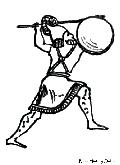
|
Assyrian Soldier
|
|
Assyrian soldier without leggings on a hunting game. From bas-relief of Khorsabad, of the reign of Sargon (2334-2279 B.C.) |

|
Foot Soldier Of The Army Of Sennacherib
|
|
Foot soldier of the army of Sennacherib (B.C. 712-707), from a bas-relief in the British Museum. The soldier is wearing conical helmet, mail coat and leggings, round shield that is large and very convex. |
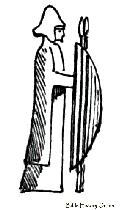
|
Persian Warrior
|
|
Persian warrior from a bas-relief of Persepolis (B.C. 560) with cast found in the British Museum. The warrior has an exceedingly convex high shield and one piece helmet with ear and neck coverings. |
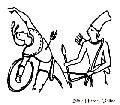
|
Egyptian Soldiers Fighting
|
|
Egyptian soldiers fighting, from mural paintings of Thebes. With strange form of headdresses and using lances and arrows as offensive weapons. |
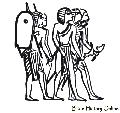
|
Egyptian Soldiers From Theban Bas Reliefs
|
|
Ancient Egyptian soldiers from Theban bas-reliefs. Armed with shields with sight-holes and khops. |
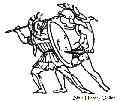
|
Greek Combatants From A Painted Vase
|
|
Greek combatants from a painted vase in the Louvre. The warriors are armed with casques, breastplates and bucklers. Their offensive weapons are lance and sword. |

|
Ancient Greek Hoplite
|
|
Hoplite, regular soldier of Ancient Greek City states with trefoil shaped buckler. Wears an Etruscan shaped helmet. From treatise of M. Rodios. |
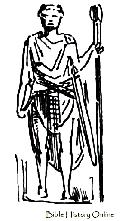
|
Roman Auxiliary Soldier
|
|
A Roman soldier, a veles or auxiliary soldier from tombstone found in the Rhine.Soldier is armed with two javelins, with sword on the right and dagger on the left and wears small apron made of straps of leather studded with pieces of metal. Found in the Museum at Mayence and a cast is in Museum of Artillery, Paris. |

|
Roman Legionary Soldier Front And Back View
|
|
Front and back view of ancient Roman legionary soldier. Figure is taken from bas-reliefs on the Trajan column. |
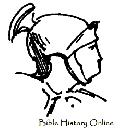
|
Bust Of A Roman Legionary Soldier
|
|
Bust of an ancient Roman legionary soldier wearing a crested helmet, from the Trajan column. |

|
Head Of A Hastarius
|
|
Head of a hastarius (Roman legionary soldier) belonging to another legion, from the Trajan column. |
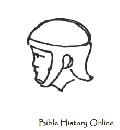
|
Head Of A Hastarius
|
|
Head of a hastarius (Roman legionary soldier) belonging to another legion, from the Trajan column. |

|
Combatants From The Ivory Cover Of The Antiphonary Of Saint Gregory
|
|
Combatants from the ivory cover of 18th century manuscript the Antiphonary of Saint Gregory, from the library of Saint Gall in Switzerland. Has a Roman and byzantine character which may have probably come from a diptych. The two combatants are shown with shields that have single loop on the arms and Moses-like horn head gears. |
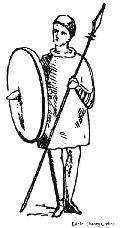
|
German Man At Arms From 9th Century
|
|
German man-at-arms from beginning of 9th century. The warrior wears no beard, with round helmet and carrying a rounded shield with boss. From a miniature in Wessobrunn MSS, preserved in the Munich Library. |

|
Lombard King From Leges Longobardorum Of 9th Century
|
|
Lombard king from Leges Longobardorum of the ninth century in the Stuttgart library. The king wears his beard, but with the chin bare. The shield is also of the elongated square and convex shape. |
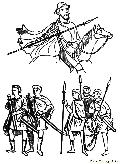
|
Horseman And Foot Soldiers From The Miniatures Of The Codex Aureus
|
|
Horseman and foot soldiers from the miniatures of the Codex Aureus, of 8th and 9th century that is now at St. Gall. |
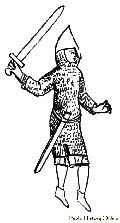
|
German Warrior Of The 10th Century
|
|
German warrior of the tenth century with conical shaped helmet with nose-piece and wearing hauberk of mail with long sleeves. From the manuscript of Martyrologie in Stuttgard Library. |
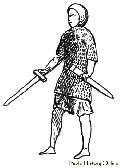
|
Warrior In Large Hauberk Of Mail
|
|
Warrior with large hauberk of mail with short-sleeves and hood. From the bas-reliefs of a reliquary in beaten silver of the end of 9th century. |
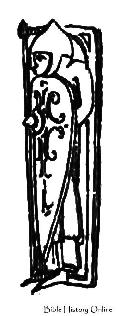
|
Man At Arms Of The 10th Century
|
|
Man-at-arms of the 10th century, from a statuette. 3 inches high. the conical helmet has a nose-piece with broad shape at the base. The sword is pointed, shield is long, pointed and with boss and the coat of mail is long. |
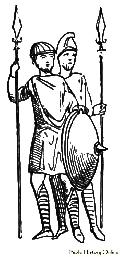
|
Anglo Saxon Men At Arms
|
|
Anglo-Saxon men-at-arms from the 10th century manuscript Prudentius Psychomachia in the library of the British Museum. The defensive armour consists of round shield with boss and casque with rounded shell. |
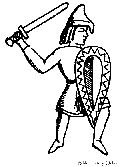
|
The Duke Of Bourckhard Of Swabia
|
|
The Duke of Bourckhard of Swabia from bas-relief in the Basilica of Zurich in Switzerland. The helmet and sword recalls those of the 10th century. |
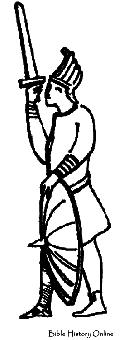
|
Anglo Saxon Man At Arms
|
|
Anglo-Saxon man-at-arms from the miniatures of 11th century Anglo-Saxon manuscript, the Aelfric. The sword-handle is trilobed. While the hauberk with long sleeves, the shield and helmet does not resemble those of Normans. |
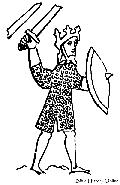
|
Anglo Saxon Warrior From The Aelfric Manuscript
|
|
Anglo-Saxon warrior from the Aelfric manuscript, of the beginning of 11th century. The warrior has a beard, with trilobed sword-handle and round shield. The hauberk is ringed, without leggings but with close fitting breeches. |
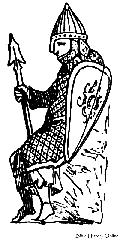
|
French Warrior From Bas-relief In The Cloister Of Saint Aubin
|
|
French warrior from bas-relief in the cloister of Saint Aubin at Angers. The warrior wears a conical helmet with nose-piece, heart shaped buckler, Germanic lance and large hauberk of trellised mail with long sleeves and hood. The shield is observed to be adorned with paintings, which probably represent personal armorial bearings. |

|
German Equipment Of 11th Century
|
|
German equipment of the 11th century, from the statue of one of the founders of the Cathedral of Naumburg. The casque is similar to that in the Codex of Aureus at Saint Gall. The right leg is without armour and the warrior is seen with beard on the chin. |
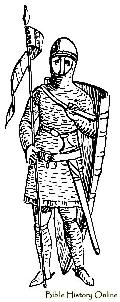
|
German Warrior Of 11th Century
|
|
German warrior of the 11th century. Wearing hauberk with long sleeves, hood and breeches and leggings in mail. From the Jeramias Apocalypsis, in the library at Darmstadt. |

|
German Man At Arms End Of 12th Century
|
|
German man-at-arms from end of 12th century from the embroideries on the mitre in the Convent of Seligenthal at Landshut in Bavaria. From National Museum of Munich. |
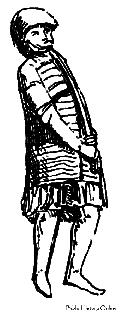
|
German Warrior From A Stone Sculpture Of The 12th Century
|
|
German warrior from a stone sculpture of the 12th century, at the gate of Heimburg in Austria. The hauberk with long tight sleeves and hood appears to be of thongs covered with iron. Sword resembles that of Dacian sabre. |

|
Anglo Saxon Warrior
|
|
Anglo-Saxon warrior recognizable by his round shield with boss, and whose defensive armour does not differ in other things from the Norman. The sword is very long in the blade and has a simple pommel. From Bayeux Tapestry. |

|
Norman Warrior Figure Probably Meant To Be William The Conqueror
|
|
Norman warrior of the 11th century who is probably meant to be William the Conqueror for having armed legs like the body. This figure wears large trellised hauberk with sleeves, breeches, leggings and hood in one piece. From Bayeux Tapestry. |

|
Count Of Barcelona - Don Ramon Berenger IV
|
|
Count of Barcelona, Don Ramon Berenger IV (1140), from an engraved seal. The conical helmet has a nose-piece, and the rest of the armour seems to consist of a hauberk with hood and breeches and leggings of mail, all in one piece. The long shield has a coat of arms on one of his seals and stripes on the other. The lance is seen with pennant. |
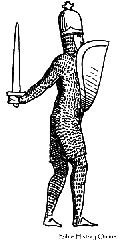
|
Louis VII The Young
|
|
Louis VII, the young (1137-1180), from his seal. The coat of mail has a hood, close fitting sleeves, breeches and leggings, The helmet has a rounded shell without a nose-piece, a cross as a crest and the buckler differs greatly from the Norman one. |

|
German Warrior From The Mural Paintings In Cathedral Of Brunswick
|
|
German warrior from the mural paintings on the Cathedral of Brunswick. The coat of scale armour resembles the Roman squamata, has a large shield, the pommel of the sword is double-lobed and there are metal rings that encircles the knees. |
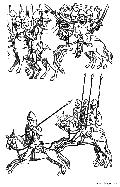
|
Bohemian Or German Warriors From Manuscript Voleslav Of Bohemia
|
|
Bohemian or German warriors from manuscript Voleslav of Bohemia in 13th century. |

|
Richard I Coeur De Lion
|
|
Richard I. Coeur-de-Lion (1189-1199) from a seal. The coat of mail has tight fitting sleeves and hood but without hose. The leggings are also of mail while the buckler seems to be the forerunner of the small shield of 13th century. The helmet with rounded top is of Northern Germanic origin. |

|
Knight Of Neufchatel Of The Year 1372
|
|
Knight of Neufchatel of the year 1372. It represents Rudolph II, who died in 1196. |

|
Armour Of Neufchatel Knight
|
|
Armour of a Neufchatel knight. This armour is drawn from the exact fac-simile of the monument to the Count of Berthold, who died in 1258, at the time when this sculpture was carved. The plate-armour has greaves or jambs, but the shield is small. |

|
Spanish Warrior Of 14th Or 15th Century
|
|
Spanish warrior of end of 14th century or beginning of 15th century, Armed with hooded hauberk, without helmet, from a fragment sculpture in the Alhambra. This bas-relief is seen with small Gothic letter inscriptions which were not used before 1360. |
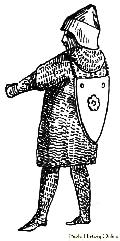
|
Burgundian Warrior From The Illumination Of A Manuscriot A Roman History
|
|
Burgundian warrior from the illumination of a manuscript in the Library of the Arsenal at Paris, a Roman History, which appears to have been written for the Duke of Burgundy. The armour is seen to still consists of mailed hauberk, and the salade kind of helmet. The small buckler also of the 13th century is seen at the back of the warrior. |
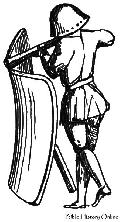
|
Man-At-Arms Firing A Small Hand Cannon
|
|
Man-at-arms firing a small hand cannon, from a manuscript of the 15th century. |

|
Spanish Men At Arms From Mural Painting In The Cathedral Of Mondoneda
|
|
Spanish men-at-arms from a mural painting dating about the end of 14th century, in the Cathedral of Mondoneda representing the Massacre of the Innocents. |











































